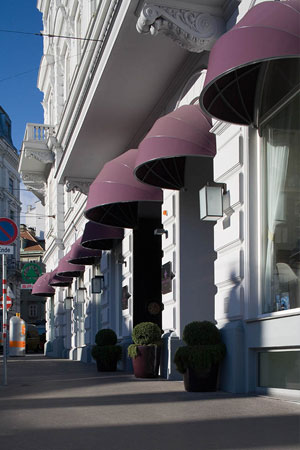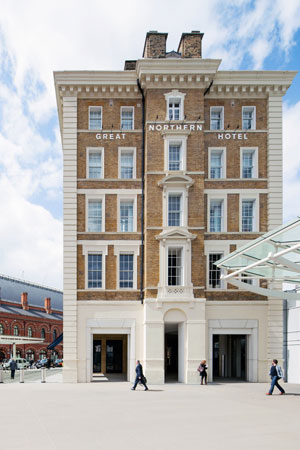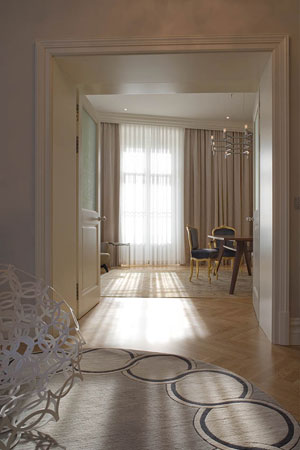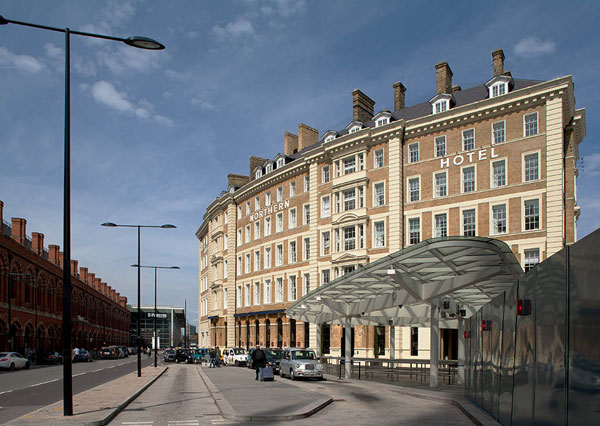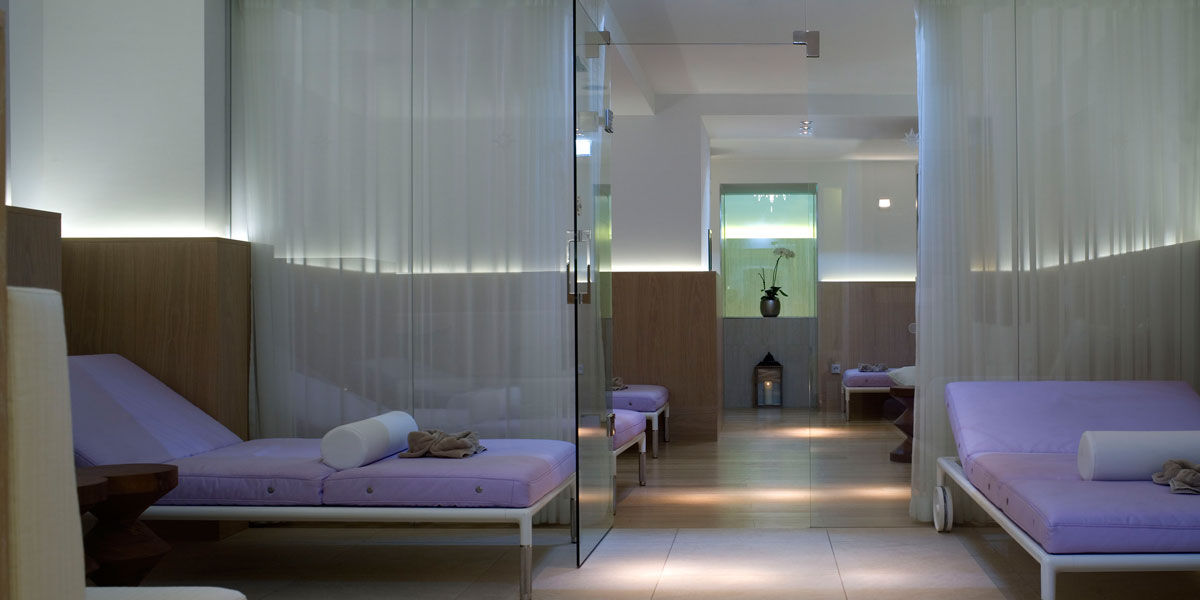
Scene setting in hotels
Creating a successful hotel is all about setting a filmic scene, and that’s something our Chiltern Firehouse client Andre Balazs knows well, having done so expertly in all his other hotels around the world, from Chateau Marmont in Hollywood with its Craig Ellwood designed bungalows to The Mercer in New York.
In her article Chiltern Firehouse Reborn in the FT’s How To Spend It magazine, Maria Shollenbarger draws a fruitful analogy between hotels and theatre: “A great hotel is a performance in progress. More than merely a place to lay one’s head, it’s a stage on which endlessly intersecting narratives play out to a backdrop of meticulous set and sound design, expertly calibrated lighting and some careful casting in the form of beautifully turned out, genial staff.”
It’s a useful comparison. The hotel architects role is to create the backdrop for the scene to flourish, placing the architectural and design work within a culturally informed context in order to appeal to the clientele they want to attract. Every foot of space has been carefully considered, designed, and orchestrated to make people behave in a particular manner. Philippe Starck is quoted commenting approvingly on this attention to detail in the Vogue magazine article A Night At The Chiltern Firehouse by Violet Henderson: “It's highly controlled: when you look at the details, you see everything is designed," he says.
At Chiltern Firehouse, the end result of such careful and intelligent design is an informal, relaxed and convivial ambience that encourages adventure, fun, exhibitionism and flirtation, creating a seductive and hedonistic scene that becomes a self-fulfilling prophecy. As the FT article says, in the restaurant that was the former carriage room “something modest of bygone London merges with something more overtly glamorous of Hollywood, with a hint of Continental sex appeal thrown in”.
Vogue too praises the hotel’s Ladder Shed Lounge which: “This is the anti-Met Bar, the salve to the aching hangover of Nineties cool and the gimmicky transience of Noughties pop-ups.” Says Balazs, “For me, it’s like an old-school movie: you define the role components and fill them. Who will act? Who will direct? They all come together.” In this hotel we chose a deliberate raw palette which accentuated the existing riveted iron beams, glazed Victorian bricks, cracked tiles all of which combine with the natural woven fiber ceilings, mid century furniture and intense attention to detail to the lighting of every area of the design.
Building provenance is hugely helpful in underpinning a hotel’s sense of place and setting a scene. At Chiltern Firehouse, we were able to draw on the Gothic architectural heritage of the 19th century former firehouse, designed in 1888 by Robert Pearsall before creating a seamless connection to the new building, appearing as if it was always part of the street. At the Great Northern Hotel, we worked with Lewis Cubitt’s Grade II listed building, the world’s first railway terminus hotel in 1854. Here we were able to reconfigure the rooms, the architecture and public areas to their former grandeur without suppressing the elegance of the crescent form, a key departure when we created the furniture for the hotel.
At the LaLit London Hotel at No.1 Tower Bridge, which will open in 2016 we are bringing a 19th century former grammar school by Edward Mountford back to life as a hotel, creating a restaurant in the school hall, a cocktail bar in the governors’ room, and a suite in the headmaster’s office. Other municipal buildings such as law courts, town halls and even old gaol’s make perfect candidates for rehabilitation as hotels, their building heritage a crucial ingredient in the creation of hotel ambience.
Sometimes the intention is to contrast with, rather than reflect, the surroundings that define the place. In 1955, SOM’s uncompromising Gordon Bunschaft design of the Hilton in Istanbul aimed to convey the power and wealth of America in a statement of political architectural colonialism. It was the largest hotel in Europe and the Middle East on opening. It became a factor in the Cold War rivalry between the USA and USSR, as the Soviets intentions were aligned in exporting buildings with a utopic aura whose scale and prominence struck discord with the traditional architectural forms and cityscape, even if the cultural confrontation between Capitalism and Communism represented opposite ideologies.
As post war architecture is as much a part of our heritage today, we find ourselves with new commissions in municipal buildings of that period, including the Brutalist Camden Town Hall, soon to be the Standard Hotel, a contrasting neighbour to our Great Northern Hotel, historically purpose built like the Hilton, allowing new appraisements of hotel space to exist in our appreciation of architecture today.
Sometimes the intention is for the natural landscape and urban morphology to be prominent with design being concealed as the background architectural scenery. Resort design traditionally springing from German seaside resorts and European spa towns, becoming popular in Victorian England where hotels were designed to appear like mansions forming a streetscape with royal patronage led to the promenades and Riviera’s that form our environments today. Luxury playgrounds have existed from the Amalfi Coast in Roman times , to palaces along the Bosphorus, to individual boltholes like the famous Eden Rock in St. Barts where glamourous legends Great Garbo and Howard Hughes retreated to this tiny gem built within the rock promontory. Our project in Dalmatia, the Adam hotel follows in the tradition of palace garden design of the 19th century in the unesco city which is home to the Romans’ Diocletian’s.
Recently we were asked to be involved in an ambitious project for a Tea plantation in Sri Lanka where the intention is to retain the community, the terraced topography and to embed buildings to form a resort that can not be seen - to disappear behind the verdant landscape, this. Similarly, at the Beach Samui, our resort opening later this year in Thailand, is a relaxed scene which led to the generation of modern building - conceived to match the colour of the emerald sea and the bleached colour of the sand, with overflowing borgonvillia - in this national marine park. Concealed behind coconut grove it follows the notion of recreational vacation, just like the golden days of 1930’s ski resort which developed communities, beginning as rustic sheep huts, to cabins, to unpretentious lodges through to todays luxury mountain villages offering perfect vacation experiences. Unlike the Hilton Bosphorus, or Marcel Breuer’s Flaine ski resort, which create places by their presence with their comfortable familiarity of ‘little America’ in a place where you don’t leave – the Beach Samui and the Adam Hotel similarly are stand alone pavilions, but rather than alienate from the local habitat – they intertwine with it.
Sense of place in a hotel can be strongest where the designer has had the opportunity to work on everything from the architecture of the building right through to the choice of door handles, as at Arne Jacobsen’s sophisticated SAS Hotel Royal in Copenhagen, or Aalto’s Savoy Hotel in Helsinki. We were lucky enough to almost achieve this, with the exception of ironmongery, baths, WC’s and toilets at the Great Northern Hotel. We are beginning to work with British manufacturers to create our own product lines in these areas, as we perpetually evolve how we think about hotel space. We like to take a holistic approach to commissions – to paraphrase the great architect Luis Barragán, architecture, landscape and gardening shouldn’t be divided but should instead be treated as one. For that reason, where possible we like to intertwine architecture, interiors, furniture and landscape together to maximise the impact of our design vision, and create places with longevity. In doing so, we often capture the wider skills and talents of the applied arts such as cabinet making, inlay, gilding, lacquering as well as exploring the possibilities of mechanised craft and computer-generated manufacturing systems to realise our visions. We hope to create far more of these total environments in the future.
Usually it takes more than one voice to get the setting right - a good hotel is best created through the input of the owner and the architect in collaboration with a whole variety of other contributors, as well as the influence of the host building and the city itself. Our work expresses the character of collaborative efforts and our contribution to intelligent design to achieve something individual each time – and why the address precedes in all cases the architect in our work, and why an address begins to create its own stories from who stays there.
